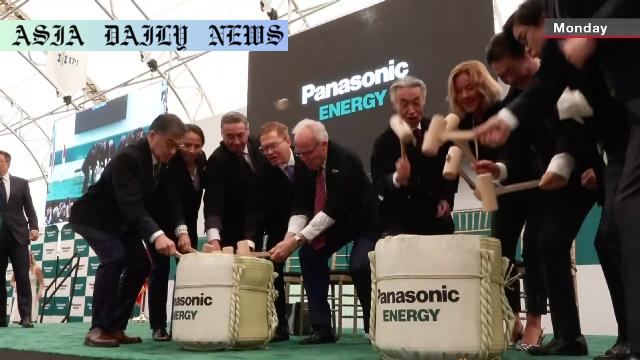Panasonic starts mass producing EV batteries in Kansas, targeting 450,000 electric vehicles annually, despite facing challenges.

Panasonic’s Move to Expand EV Battery Production
Japanese electronics powerhouse Panasonic Holdings has made significant strides in the electric vehicle (EV) sector by commencing mass production at its Kansas-based battery factory. Operated under its subsidiary, Panasonic Energy, the company has invested an impressive $4 billion in the plant, marking it as their second EV battery factory in the United States. With an annual production capacity aimed at powering 450,000 vehicles, this facility represents a bold maneuver in scaling up to meet the growing demand for clean energy solutions.
Employment and Capacity Goals
The Kansas facility promises to be a major economic driver in the region, with plans to employ up to 4,000 workers. This hiring effort not only supports Panasonic’s production goals but also injects employment opportunities into the local community. The output from the factory is intended to strengthen the electric vehicle market, contributing significantly to expanding infrastructure for cleaner transportation globally. However, the timeline for reaching full production capacity, originally slated for March 2027, has been delayed due to unforeseen challenges.
Challenges Facing the Project
Despite the lofty goals and substantial investment, Panasonic has encountered several setbacks. A significant hurdle comes from one of its primary customers, Tesla, which has seen a drop in sales. This decline poses a challenge for Panasonic Energy, given that Tesla represents a key partnership. Moreover, the expiration of US federal tax credits for EV purchases this September complicates the business landscape. With such tax incentives typically acting as a significant driver for EV sales, their discontinuation could slow the market’s trajectory, just as Panasonic is focusing on diversifying its customer base.
Future Plans and Strategies
While challenges abound, Panasonic is seeking to mitigate risks by forming new partnerships and clients within the EV ecosystem. The company recognizes the need to pivot in a competitive market and intends to leverage its technological expertise to meet diverse customer needs. Expansion into regions potentially less affected by US policy changes may also form a key part of Panasonic’s strategy moving forward. The upcoming years will likely determine how well the firm adapts to the evolving landscape of electric vehicle manufacturing and sales.
The Role of the Kansas Facility in the EV Industry
Global dynamics in EV manufacturing are shifting rapidly, and the Kansas facility demonstrates Panasonic’s ambition to remain a key player. This initiative not only expands Panasonic’s geographical footprint but also strengthens its influence in the US market where EV regulations, consumer demand, and technology are rapidly evolving. The company’s readiness to invest significantly underscores the rising importance of battery production in achieving a sustainable transportation future.
Conclusion
Despite delays and hurdles, Panasonic’s Kansas EV battery plant highlights its commitment to advancing the electric vehicle revolution. While obstacles such as Tesla’s sales dip and the ending of tax incentives pose risks, the strategic resilience of expanding customer bases and adapting to market trends will be crucial for Panasonic’s success. As the EV industry continues its growth trajectory, groundbreaking projects like Panasonic’s remain instrumental in shaping a sustainable, electric-driven future.
Commentary
Panasonic’s Expansive Investment
Panasonic’s $4 billion investment in the Kansas EV battery factory marks a substantial commitment to advancing clean energy and electric mobility. This bold move underscores the company’s vision of being a leader in sustainable technology, bringing together innovation, infrastructure, and employment. Projects of this magnitude not only highlight technical ambition but also pose questions about market readiness and strategic adaptation in a competitive environment.
Challenges With Tesla’s Market Shift
One of the most striking challenges for Panasonic is the declining sales of Tesla, one of its most important customers. The interconnectedness of companies like Panasonic, Tesla, and others in the EV ecosystem reveals the complexity of relying on a few major players. Future strategies should likely pivot to broadening customer bases and finding additional markets to ensure greater stability against the volatility of singular partnerships.
A Compounded Impact With Tax Incentives Ending
The looming expiration of federal EV tax credits in the United States is another unsettling development. Tax incentives play a critical role in encouraging early adoption of green technologies. Their discontinuation could stall momentum in an already fluctuating market, especially at a time when companies like Panasonic are scaling operations to meet long-term demand. Legislative developments will need close monitoring as they could significantly influence consumer behaviors and market dynamics.
The Broader Significance
Beyond the headlines about investments and delays, Panasonic’s Kansas plant represents a broader shift in global energy priorities. By operating a high-capacity battery production facility domestically in the US, the firm supports the country’s goal of renewable energy independence and sustainable transportation, positioning itself as a driving force in the EV industry. Nonetheless, the immediate future offers a mixed challenge of opportunities and hurdles.
Final Thoughts
Panasonic’s foray into large-scale battery production demonstrates a shift toward long-term sustainability and market leadership. However, as the landscape evolves, flexibility and proactivity will be critical components for tackling the challenges ahead. Whether it’s through creating new customer partnerships, leveraging emerging technologies, or navigating policy changes, the company’s resilience and strategic foresight will shape its future in the industry.


